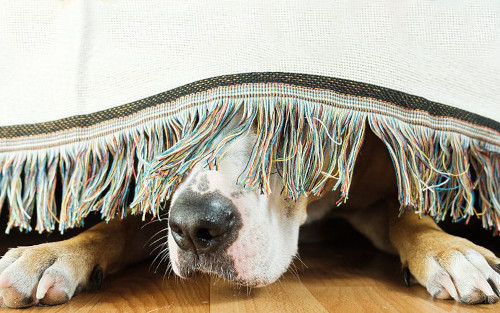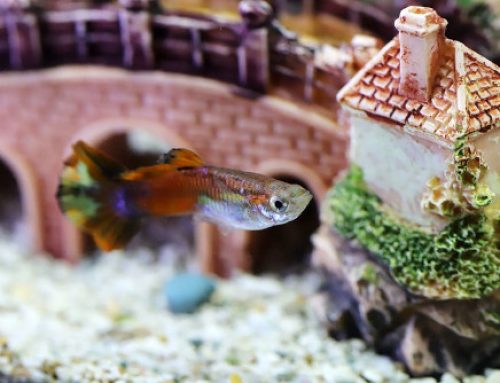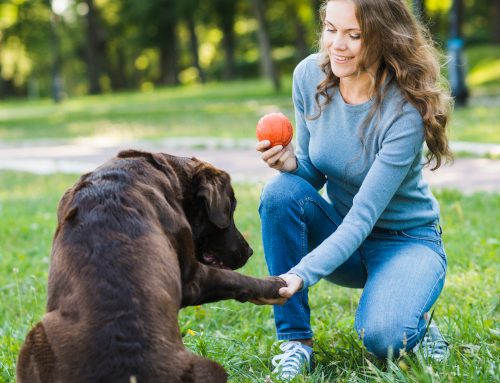Fear of thunderstorms is a common concern for many dog owners. Our furry friends can become highly anxious when dark clouds loom, lightning flashes, and thunder rolls. This distressing behavior may include pacing, heavy panting, and seeking shelter.
Understanding why dogs experience fear during thunderstorms is crucial. The combination of loud noises, flashes of lightning, changes in atmospheric pressure, and smells from rain can trigger anxiety. The need to address this fear is important for their well-being and to prevent increasing anxiety levels.
There are effective strategies to help dog owners keep their dogs calm during thunderstorms. We will look into each strategy in detail, equipping you with the tools necessary to create a sense of calm and security for your beloved companion during challenging weather events.
 Key Factors that Contribute to Storm Anxiety
Key Factors that Contribute to Storm Anxiety
Noise
Thunderstorms bring with them loud claps of thunder that can startle even the bravest of dogs. Those sudden, booming sounds can be overwhelming and trigger a fear response in our furry companions. Add the additional noises created by rain, wind, and hail. This combination of unusual sounds could raise stress levels!
Unusual feelings
But it’s not just the noise from the thunder that gets some dogs worked up. Thunderstorms also come with vibrations. The rumbling thunder can create vibrations, which dogs can feel. Imagine feeling the ground shake beneath you without knowing why.
And there’s another unusual feeling: storm-related changes in atmospheric pressure. During a thunderstorm, the atmospheric pressure can drop rapidly, creating an unsettling sensation for our dogs. This sudden shift in pressure can leave them feeling on edge and anxious.
Light flashes and smells
Although minor by themselves, bright flashes and strong smells can add to the factors causing anxiety. Light flashes are likely issues because the flash is often followed closely by thunderclaps. Dogs have a highly advanced sense of smell. Rain-saturated air may concentrate odors.
Signs of Storm-Related Anxiety
Now that we know why thunderstorms make our dogs anxious, let’s talk about the signs to look out for. When a storm approaches, you may notice your dog panting excessively. Panting is a common way for them to cope with stress. Additionally, they may start pacing back and forth, unable to settle down. Some dogs may even hide in secluded areas, seeking comfort and a sense of security. Trembling is another telltale sign of anxiety in dogs during thunderstorms. You might see them shivering or trembling, trying to cope with their fear.
Addressing dog anxiety during thunderstorms is crucial for their well-being and to prevent destructive behavior. When dogs are anxious, they may engage in destructive activities like chewing furniture or scratching doors and walls. By addressing their anxiety, we not only alleviate their distress but also help create a calmer environment for everyone in the household.
Understanding why dogs get anxious during thunderstorms and recognizing the signs of their anxiety allows us to take proactive steps to help them. So, let’s explore effective strategies that keep our furry friends calm during these stormy moments.
When it comes to thunderstorms, having a safe space for your dog is necessary. Creating a designated area where they can seek refuge can go a long way in keeping them calm during these loud and boisterous events.
Calm Retreat
The first step is to identify a suitable location in your house for your dog to retreat to during thunderstorms. An interior room, basement, or bathroom are often ideal choices. These areas are typically more insulated and can provide a sense of security for your furry friend. The goal is to select a space away from windows, limiting storm sounds.
Once you’ve chosen the location, it’s time to create a cozy and secure environment within that safe space. Start by adding comfortable bedding for your dog to relax on. This could be their favorite dog bed or even a soft blanket. Providing them with familiar items, such as their favorite toys, can also help create a sense of familiarity and comfort.
Minimize or Mask Stimuli
In addition to creating a cozy space, it’s important to minimize external stimuli that can contribute to their anxiety. Closing the curtains or blinds can help block out the flashes of lightning, reducing their exposure to visual stimuli that can be distressing. Consider reducing the noise level in the house as well. Turn down the volume on your TVs to minimize additional loud noises that could exacerbate their fear. Alternatively, you could mask some noises with calming or distracting music.
Remember, the goal is to create a calm and soothing environment for your dog. By preparing a safe space with comfortable bedding and familiar toys and minimizing external stimuli, you provide them with a refuge where they can feel secure during thunderstorms.
In the next sections, we’ll explore additional strategies to help keep your dog calm during thunderstorms. We’ll discuss desensitization and counterconditioning techniques, distraction and calming methods, as well as behavior modification techniques that can make a positive difference in their anxiety levels. By implementing these strategies, you’ll be well-equipped to provide the support and comfort your dog needs during those stormy moments.
Desensitization and Counterconditioning
Desensitization and counterconditioning techniques can be powerful tools in helping your dog overcome their anxiety during thunderstorms. One effective technique is gradual exposure to recorded thunderstorm sounds. Start by playing the sounds at a low volume while engaging in activities that your dog enjoys, such as playtime or giving them treats. The key is to create a positive association with the thunderstorm sounds. As your dog becomes more comfortable, gradually increase the volume over multiple sessions. The goal is to desensitize them to the sounds, making them less fearful in the long run.
Pairing positive experiences with thunderstorm stimuli is another valuable approach. During a thunderstorm, engage your dog in activities they love, such as playing their favorite game or offering them treats. By providing positive experiences, you create an association between the thunderstorm and something enjoyable. This can help shift their perception from fear to a more positive and relaxed state.
Consistency and patience are key when using desensitization and counterconditioning techniques. It’s important to understand that results may not be immediate, and progress can take time. Remember to be patient with your dog and celebrate small victories along the way.
Over time, with consistent use of these techniques, you can help alleviate your dog’s anxiety during thunderstorms. The goal is to gradually reduce their fear response and provide them with a sense of security and calmness.
Next, we’ll explore additional strategies that can complement desensitization and counterconditioning techniques. We’ll discuss distraction and calming methods, as well as behavior modification techniques that can further support your dog in managing their anxiety during thunderstorms. Let’s continue our journey to equip you with the tools and knowledge you need to keep your furry companion calm during thunderstorms.
Distraction and Calming Methods
When it comes to keeping your dog calm during thunderstorms, distraction and calming methods can be incredibly helpful. By engaging them in activities that divert their attention and providing soothing aids, we can help alleviate anxiety.
One effective way to distract your dog during a thunderstorm is through interactive play or puzzle toys. These toys can keep their minds occupied and redirect their focus away from the storm. Engage in playtime with toys that require mental stimulation, such as treat-dispensing puzzles or interactive games. Not only will this keep them engaged, but it will also provide a positive and enjoyable experience.
In addition to interactive play, providing long-lasting chews or treats can be a great way to keep your dog occupied and distracted during a thunderstorm. Chew toys that require more effort and time to consume, such as sturdy bones or durable rubber toys, can keep them engaged for extended periods. This can help reduce their anxiety by redirecting their focus toward something enjoyable and tasty.
Pheromones
Calming aids can also play a significant role in helping your dog stay calm during thunderstorms. Pheromone diffusers, which release synthetic pheromones that mimic those produced by a nursing mother, can have a soothing effect on dogs. These diffusers create a comforting environment and can help reduce anxiety.
Anxiety wraps
Anxiety wraps, such as specially designed vests or wraps, provide gentle pressure that help calm your dog during stressful situations. The snug fit of the wrap can help reduce anxiety by providing a sense of security. Some dog owners have also found success with natural remedies, such as herbal supplements or essential oils. However, it’s important to consult with a veterinarian before using any natural remedies to ensure their safety and effectiveness for your specific dog.
Remember, not all methods work for every dog, so it’s important to find what works best for your furry friend. Each dog is unique, and their response to various distractions and calming aids may differ. Be patient and observe how your dog responds to different techniques to determine what brings them the most comfort.
In the next sections, we’ll explore behavior modification techniques and additional strategies that can further assist you in keeping your dog calm during thunderstorms. By combining these approaches, you’ll be well-equipped to support your dog and provide them with a sense of peace during those stormy moments.
Behavior Modification
Implementing behavior modification techniques can be a valuable approach to help your dog develop calm behaviors during thunderstorms. By using reward-based training and positive reinforcement, we can teach them to stay calm and composed in the face of their fears.
Reward Training
One effective technique is reward-based training. During calm moments, when there are no thunderstorms, you can start training sessions to teach your dog specific behaviors associated with calmness. For example, you can teach them to lie down on a designated mat or bed when you give a specific command. The key is to reward them with treats, praise, or a clicker when they exhibit the desired calm behavior. Through consistent training and positive reinforcement, they will learn to associate calm behaviors with positive rewards.
Positive reinforcement is crucial in reinforcing calmness during thunderstorms. When your dog displays calm behavior during a storm, make sure to provide immediate positive reinforcement. This can include treats, praise, gentle strokes, or even a calming and reassuring voice. By rewarding their calm behavior, you reinforce the idea that remaining calm during thunderstorms is desirable and brings positive outcomes.
However, it’s important to note that every dog is unique, and behavior modification techniques may not be effective for all. If you find that your dog’s anxiety persists despite your efforts, seeking professional help from a certified animal behaviorist is recommended. These experts have the knowledge and experience to assess your dog’s specific needs and develop a tailored behavior modification plan to address their anxiety during thunderstorms.
Remember, behavior modification takes time and patience. Consistency in training and reinforcement is key to achieving positive results. Celebrate even the smallest progress your dog makes and be understanding if setbacks occur. With dedication and perseverance, you can help your furry companion develop the necessary skills to remain calm and composed during thunderstorms.
In the following sections, we’ll recap the strategies we’ve discussed so far and provide additional tips to keep your dog calm during thunderstorms. By combining the various techniques and approaches, you’ll be well-equipped to support your dog through these challenging weather events.
Your Calming Attitude
As a dog owner, your presence and demeanor play a crucial role in keeping your furry friend calm during thunderstorms. By being a calm and supportive presence, you can help reassure them and provide the comfort they need.
One of the most important things you can do is to display a calm demeanor yourself. Dogs are highly attuned to their owner’s emotions, and they can sense your anxiety or stress. By remaining calm and composed, you can help signal to your dog that everything is alright. Speak in a soothing and gentle tone, maintaining a relaxed posture. Your calm demeanor can have a calming effect on your dog, helping them feel more secure during the storm.
It’s essential to avoid punishing or scolding your dog during anxious episodes. Remember, their fear during thunderstorms is genuine and beyond their control. Punishment or scolding will only add to their stress and anxiety. Instead, focus on providing reassurance and support. Redirect their attention to positive distractions or comforting activities.
Physical comfort and gentle reassurance can go a long way in helping your dog feel safe during thunderstorms. If your dog seeks physical contact, offer gentle strokes or cuddles to provide a sense of security. Be mindful of their body language and respond accordingly. Some dogs may prefer to find their own cozy spot, and it’s important to respect their preferences. You can place their bed or blankets in their chosen safe space to enhance their comfort.
In addition to being physically present, you can also provide other forms of reassurance. Consider playing soothing music or using white noise machines to mask the sounds of thunderstorms. This can help create a more peaceful environment for your dog.
By being a calm and supportive presence, you can significantly impact your dog’s response to thunderstorms. Your presence alone can offer them a sense of comfort and safety. Remember, patience and understanding are key during these challenging moments.
In the following sections, we’ll summarize the strategies we’ve discussed and provide some additional tips to help you keep your dog calm during thunderstorms. By combining these approaches, you’ll be equipped with a comprehensive toolkit to support your dog and create a sense of calm during those stormy times.
In conclusion, keeping your dog calm during thunderstorms is important for their well-being and your peace of mind. By implementing the strategies we’ve discussed, you can create a safe and calm environment that helps alleviate their anxiety.
Recap
We started by understanding why dogs get anxious during thunderstorms, highlighting the loud noises, vibrations, and changes in atmospheric pressure as common triggers. And we discussed the importance of addressing dog anxiety, both for their well-being and to reduce destructive behavior.
Also we explored practical steps to keep your dog calm during thunderstorms. And emphasized the significance of preparing a safe space, such as an interior room, basement, or bathroom and creating a cozy and secure environment within it. Minimizing external stimuli, such as closing curtains and reducing noise from TVs or radios, can further contribute to a calming atmosphere.
We covered desensitization and counterconditioning techniques, gradually exposing dogs to recorded thunderstorm sounds and pairing positive experiences to help them overcome their fears. And also discussed the value of distraction and calming methods, engaging dogs in interactive play, providing long-lasting chews, and utilizing aids such as pheromone diffusers or anxiety wraps.
Behavior modification techniques, such as reward-based training and positive reinforcement, can empower your dog to exhibit calm behaviors during thunderstorms. We emphasized the importance of seeking professional help from a certified animal behaviorist if needed.
Lastly, we highlighted the significance of being a calm and supportive presence for your dog. By displaying a calm demeanor, avoiding punishment or scolding, and providing physical comfort and gentle reassurance, you can greatly contribute to their sense of security.
We encourage you to take action. Implementing these techniques will require consistency, patience, and observation. Each dog is unique, and it may take time to find the most effective combination of strategies for your furry companion. However, the effort will be worthwhile, as you create a safe haven for your dog during thunderstorms, promoting their well-being and reducing their anxiety.
By implementing the strategies we’ve outlined, you can be well-equipped to create a calm and comforting environment for your beloved dog during those stormy moments. Your dedication and care will go a long way in helping them navigate their fears and find solace. Remember, you are their source of support and reassurance.
Here’s to creating a safe and calm haven for your dog during thunderstorms!
References:
Journal of Veterinary Behavior, The effectiveness of the Anxiety Wrap in the treatment of canine thunderstorm phobia, 6/2013, https://www.sciencedirect.com/science/article/abs/pii/S1558787812001190
Hills, Helping Your Dog Cope With Thunder & Anxiety, 9/1/2022, https://www.hillspet.com/dog-care/routine-care/dog-scared-of-thunder
PURINA, Why are Dogs Scared of Thunder? Downloaded 5/30/2023, https://www.purina.com/articles/dog/behavior/why-are-dogs-scared-of-thunder
Dogster Magazine, Is Your Dog Scared of Thunder? 6 Tips for Soothing Him, 8/10/2015, https://www.dogster.com/lifestyle/6-tips-for-soothing-your-dogs-fear-of-thunder
DISCLAIMER:
We use affiliate links and pay-per-action advertising. When you use these links to buy something we may earn a commission. Thank you for visiting and for your support.
PetsWebPages.com may contain copyrighted material. This use may not have been specifically authorized by the copyright owner. The material contained in this website is distributed for informational and educational purposes. Small portions of the original work may have been used but those portions could not easily be used to duplicate the original work. This usage constitutes ‘fair use’ of any such copyrighted material (referenced and provided for in section 107 of the US Copyright Law).
All trademarks displayed here are the property of their owners and are neither an endorsement nor a recommendation for or from those organizations. With the exception of affiliate links, linking to the websites of third-party organizations is not intended to imply we recommend those organizations or that the organizations endorse or have any affiliation with PetsWebPages.com.





